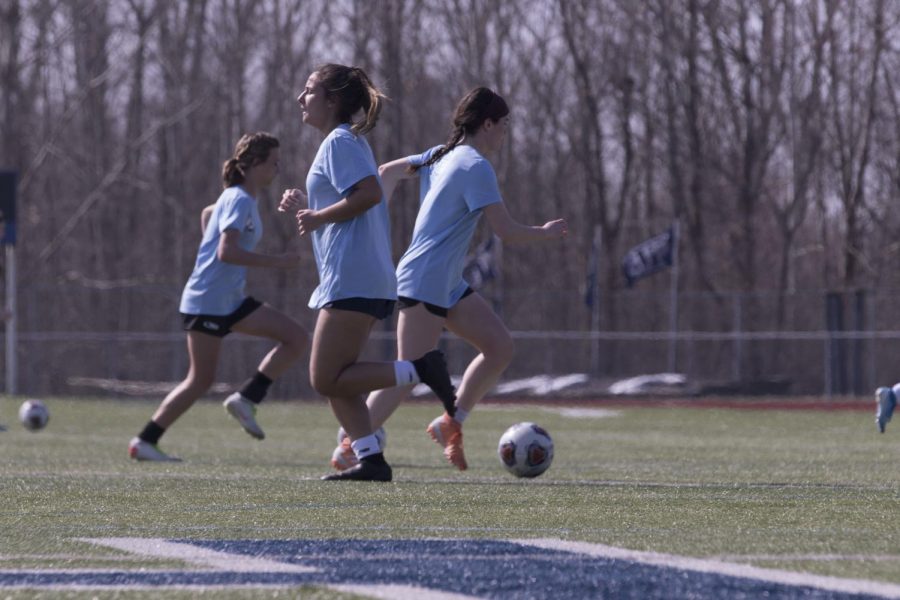Making the Cut
The effects of competition on the dynamic between athletes
It’s the first day of tryouts. Mackenzie Jones has been playing soccer since kindergarten, and is now in her senior year of high school. The cold March air is familiar, and so are the nerves. She has trained for countless hours, played countless games, and even overcome injuries. Nevertheless, at the beginning of every season, she has to step onto the turf and prove her worth to the coaches once again. The risk of not making the cut is always there, and the possibility of not playing the sport she’s known for so long is always prevalent. When the coach calls for the players, she laces up her cleats and heads onto the field. Let the games begin.
Playing sports is an essential part of the high school experience. September would feel empty without the anticipation of the homecoming game. The halls would feel barren without the plaques and awards lining the walls. But not everyone who wants to participate in a sport will get the opportunity to, because many sports will only admit those that the coaches deem fit for the team. This is what many athletes know as “making cuts”.
There are many reasons a sport would decide to make cuts or not to make cuts. Many sports make this decision based on the number of people trying out. Senior tennis player George Broyles admits that boys tennis hasn’t made cuts in the past for that very reason.
“Usually there’s not enough players to really make cuts. The team’s small enough that they don’t need to. But this year there will be enough players for cuts, so I think they’re doing it– just to make sure that we stay competitive with other schools,” Broyles said.
However, he also believes that not every sport needs to make cuts.
“I think certain sports should [cut], and certain sports shouldn’t. I mean, I think right now, the sports I do and don’t are pretty good where they’re at,” Broyles said.
Freshman Natalie Rudebeck runs cross country and is trying out for the soccer team this spring. She believes that cross country is one of such sports where making cuts is not necessary.
“I think cross country shouldn’t [cut], because there are two reasons to [join]: competition and getting in shape. So I think the kids who want to get in shape should be able to run,” Rudebeck said.
Broyles believes that a lot of the sports that do have a lot of students try out and make cuts, get that kind of following because they are amongst the more advertised.
“I think, generally, sports that do make cuts are a lot more popular. And so, it just has more and more people watching, more people go to them. They’re usually the more advertised sports than sports that don’t make cuts, but I don’t think that should be a thing. I think all the sports should be advertised and made big and all that,” Broyles said.
Like any other elimination process, there are pros and cons to its effects. Jones, who also plays basketball and tennis at FHC, feels that the process is not an indicator of effort, but simply part of the culture that comes with emotional ups and downs.
“The people who didn’t get cut, they put in the work and the effort, but also, it doesn’t necessarily mean the kids who did get cut didn’t put in the effort,” Jones said. “it’s always sad to see people who are cut, but also you’re happy for the people [who made it]. It’s kind of part of the sport, part of the culture, I guess.”
Broyles also believes that there are pros and cons to making cuts on sports teams, largely because competing for spots can create tension amongst teammates.
“I think it can create some controversy and kind of split up some friendships, especially if two friends try out and one makes it and one doesn’t,” Broyles said. “But I think if friends go into a sport, trying out, then they will both train each other and get better with each other. So I think it could have a good effect and a bad effect.”
Jones also sees how the competition of tryouts can put pressure on relationships between teammates, but she thinks that a true leader will be able to create a space of support regardless.
“I think it can [cause tension], but I think that’s also up to some of the girls on the team to step up and be a leader and to create a culture where it’s like ‘yes we’re here to make each other better, but also, we’re a family and we’re here for each other first.’” Jones said.
Your donation will support the student journalists of Francis Howell Central High School. Your contribution will allow us to purchase equipment and cover our annual website hosting costs. FHCToday.com and our subsequent publications are dedicated to the students by the students. We hope you consider donating to allow us to continue our mission of a connected and well-informed student body.










